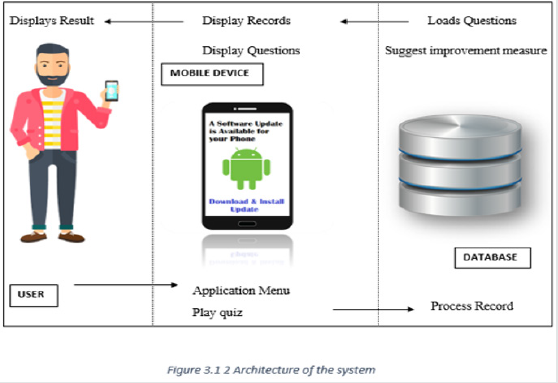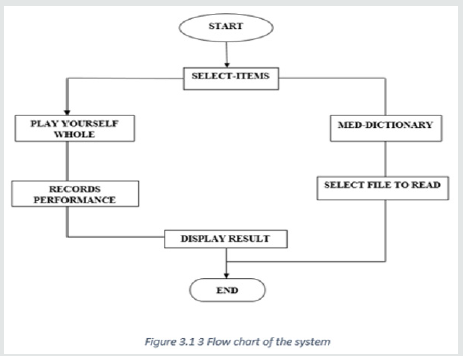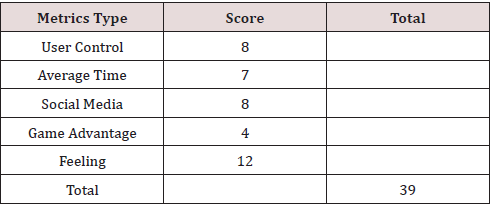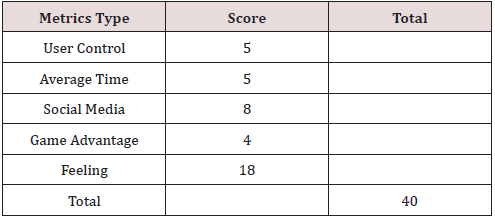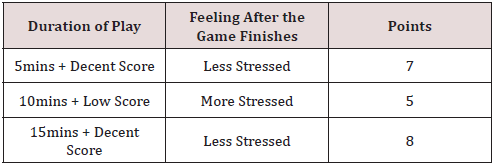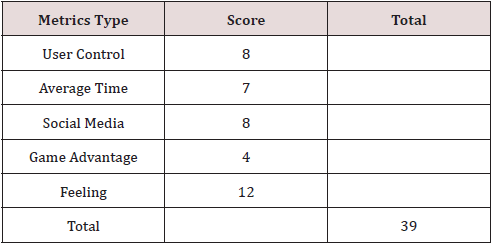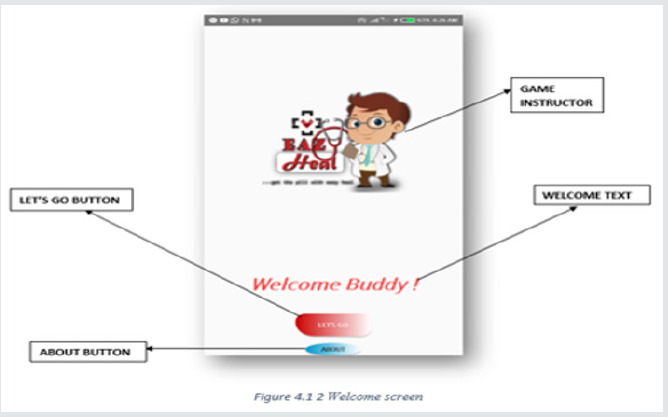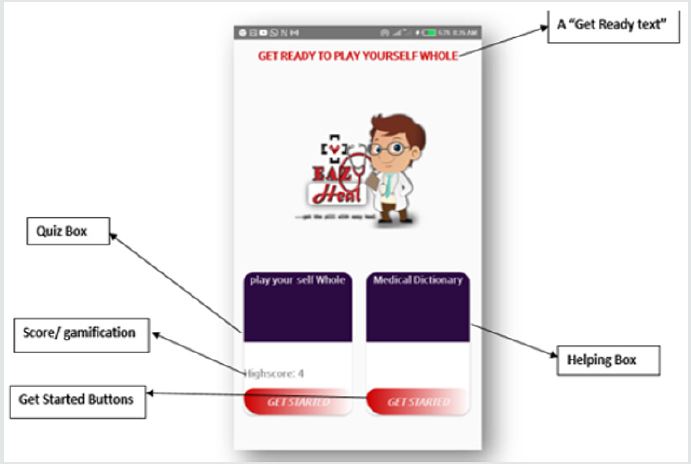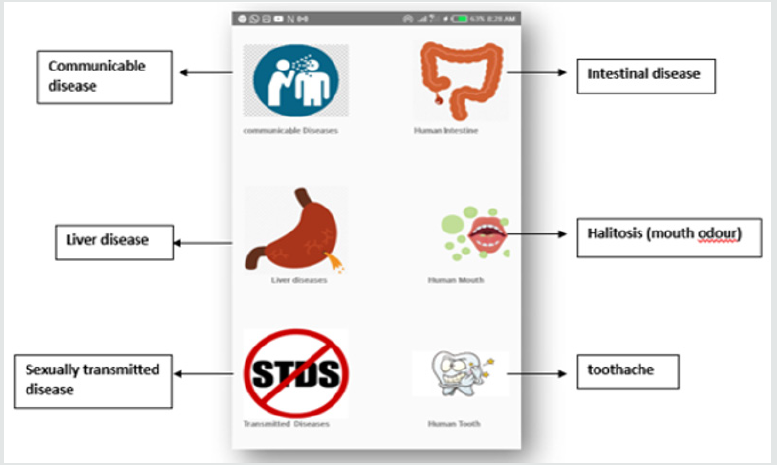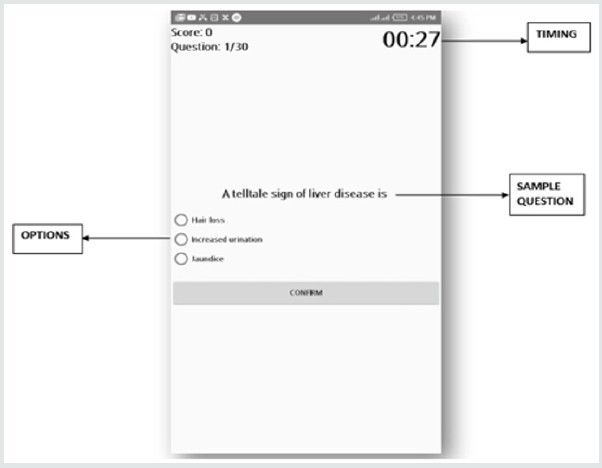
Lupine Publishers Group
Lupine Publishers
Menu
ISSN: 2637-6679
Mini Review(ISSN: 2637-6679) 
A Serious Game for Health Care Volume 4 - Issue 4
Akinbola OD1, Adebayo FO1* and Adebayo OT2
- 1Department of Computer Science, Federal University of Technology, Nigeria
- 2Department of Information Technology, Federal University of Technology, Nigeria
Received: January 09, 2020; Published: January 22, 2020
Corresponding author: Adebayo FO, Department of Computer Science, Federal University of Technology, Akure, Nigeria
DOI: 10.32474/RRHOAJ.2020.04.000193
Abstract
Gamification has the potential to provide learners with opportunities to be part of active learning, solving clinical problems, and gaining experience in risk-free surroundings, without needing to involve patients. The serious game in this paper is developed using android framework. The android device provides an interface through which the user interacts with the app. On the click to begin quiz by the user, the app loads at random, questions, from the database and displays for the user. The database as we likely may know, contains and stores every possible question that may likely be displayed randomly. The system can put a patient in a happy mood while navigating and also create a serious condition by checking user ability to focus on the display of the application features. It as well leaves a patient with an increased knowledge of the medical world and probably reveals the exact pill he/she requires. Navigation through the app is easy and direct as a result of relax mode created.
Introduction
The repertoire of computer strategies for medical education is becoming wider with the introduction of e-learning applications, game-based learning, gamification, and mobile learning Frehywot et al. [1]. A variety of serious games are ever more frequently used in medical education taking into account that medical students are younger and keen on technologies. Increasing interest toward games is evidenced by a growing number of case reports and systematic reviews about the use of games in education. Following Bergeron, we understand serious games (in what follows, games) as ‘an interactive computer application, with or without a significant hardware component, that has a challenging goal, is fun to play with, incorporates some concept of scoring, and imparts in the user a skill, knowledge or attitude which can be applied in the real world (Bergeron, 2006). Games are called serious when they have a pedagogical purpose. We adopt this wide definition of games because our purpose is that of description, and we want it to be as inclusive and useful for practical teachers as possible. Bedwell postulated nine characteristics that a serious game must have: an action language (a game offers some method of communication between the person and the game); assessment (tracks the number of correct answers); conflict or challenge; control, or the ability for the players to alter the game; environment; game fiction or story; human interaction among the players; immersion in the game; and rules and goals of the game provided to the player Bedwell et al. [2]. This definition covers a wide range of products.
Related research works
Maheu Cadotte et al. [3] presented- The Effectiveness of serious games and impact of design elements on engagement and educational outcomes in healthcare professionals and students Gentry et al. [4] presented- Serious Game and Gamification interventions for health professional education Ilaria et al. [5] presented- Gamification and Education. An attempt to shed light on the emergence and consolidation of gamification in education/ training. Surajit et al. [6] presented- Gamification as an Effective Learning Tool in Healthcare Education: A Review Sarah et al. [7] presented- Serious Gaming and Gamification Education in Health Professions: Systematic Review, but only two studies of gamification interventions were identified.
System design
This section presents the general overview of the proposed application, illustration was carried out to the developing of a mobile game application for health control. Starting from the architecture and flowchart of the design illustrating a step wise movement and navigation through the application. This application is developed to help patient improve on the effective use of cerebrum in the cerebral hemisphere, which is responsible for quick reasoning and sorting of information stored in the memory part of the human brain. It treats brain disorders, infectious diseases (cholera especially), halitosis (just to mention a few) at different levels of its operation on individual patient, as there are several causes of the diseases mentioned above. The system will track each patient based on their cognitive response, thereby creating a user profile for each user. It is also designed to assist the care giver or doctors in charge of the diseased, by reducing the stress of continuous monitoring patient and to check brain responsiveness. The architecture or systems architecture is the conceptual model that defines the structure, behaviour and more views of a system. An architecture description is a formal description and representation of a system, organized in a way that supports reasoning about the structures and behaviour’s of the system. In the Figure 1 above, the user plays the role of launching the application on an android device, does some navigations and clicks on what to do. The android device provides an interface through which the user interacts with the app. On the click to begin quiz by the user, the app loads at random, questions, from the database and displays for the user. The database as we likely may know, contains and stores every possible question that may likely be displayed randomly. System flowcharts are a way of displaying how data flows in a system and how decisions are made to control events. To illustrate this, symbols are used. They are connected together to show what happens to data and where it goes. Note that system flow charts are very similar to data flow charts. Data flow charts do not include decisions, they just show the path that data takes, where it is held, processed, and then output. The Figure 2 above describes how the user starts and is faced with two options, he clicks one and is faced with another option. It goes on and on following the necessary process until result is displayed and the quiz ends.
System description
The system design comprises several pages with dynamic functionality which includes (Main page, Quiz page and the Med- Dictionary page). The pseudocodes are given below;
MAIN PAGE
v
From Quiz Page (Displays High score)
IF user clicks on Play yourself whole THEN
Opens the Quiz activity (intent)
ELSE-IF user clicks on Med-Dictionary Page
Open Medical-Dictionary Page
ELSE
Remain on Main Page
END IF
End
QUIZ PAGE<
Begin
From Main Page
Select PLAY YOURSELF WHOLE
Shuffles database Collection
Set Score equal to zero (0)
DO
Displays Questions
Starts Timer
User Selects Desired option
IF selected option is correct THEN
Increase Score by One
END-IF
Display score and number of questions Remaining
WHILE
Question Reaches 5 0f 5
End DO
Display total result
IF user clicks on FINISH button THEN
GOTO main page
ELSE
Remain in Quiz page
End
MED-DICTIONARY PAGE
Begin
From main page
Select med-dictionary
Display medical terms
User Select med-term choice
Loads information
End.
System implementation
The testing and the evaluation of the system was made by imploring three players (Player A, Player B and Player C) to play the game of which their score was taken, cognitive, behavioural and psychological feelings was carefully observed. From the above (Tables 1-6) a careful evaluation of the system was carried out involving three players of which the results show how efficient the system can be. The evaluation of the system was carried out in order to detect and ascertain that this system is able to accomplish the aim of its development. In order for a user to experience a free flow and navigation through the system, the following pictorial representation is given. The start-up of the system from a mobile device displays the splash screen of the application which launches the user to the welcome screen. Figure 3 which is the welcome or home screen of the app contains the game instructor who is welcoming the user and tell the user what to do. Figure 4 contains the main menu of the app. The get ready text, the helping box, quiz box, the high score(gamification) and the get started active buttons. On clicking the “Get started” button in the helping box, it refers the user to fig 5 below (some medical terms which they could read about at their will) Figure 5 above which contains concrete information about some common health diseases which can be as well very helpful to the user Figure 6 is a snapshot of quiz in progress providing three (3) options to every question, the user clicks an option of his choice and clicks the “confirm” button to verify if correct or wrong. At the selection of the correct answer, the option displays green for the right answer and turns the others red, this includes a notification telling if correct or wrong
Conclusion
Based on the challenges encountered in the course of this project, for future research, technology is becoming easier to use and many systems incorporate accessibility features to support users with impairments. On the note above, It is recommended that every community to shift a great deal of attention to this side of the world to make medical services easily accessible.
References
- Frehywot S, Vovides Y, Talib Z, Mikhail N, Ross H, et al. (2013) E-learning in medical education in resource constrained low-and middle-income countries. Human resources for health 11(1):1-4.
- Bedwell WL, Pavlas D, Heyne K, Lazzara EH, Salas E (2012) Toward a taxonomy linking game attributes to learning: An empirical study. Simulation & Gaming 43(6):729-760.
- MaheuCadotte MA, Cossette S, DubéV, Fontaine G, Mailhot T, et al. (2018) Effectiveness of serious games and impact of design elements on engagement and educational outcomes in healthcare professionals and students: a systematic review and meta-analysis protocol. BMJ open 8(3):e019871.
- Henderson BW, Gentry EG, Rush T, Troncoso JC, Thambisetty M, et al. (2016) Rho‐associated protein kinase 1 (ROCK 1) is increased in Alzheimer's disease and ROCK 1 depletion reduces amyloid‐β levels in brain. Journal of neurochemistry138(4): 525-531.
- Pietrantonio F, Petrelli F, Coinu A, Di Bartolomeo M, Borgonovo K, et al. (2015) Predictive role of BRAF mutations in patients with advanced colorectal cancer receiving cetuximab and panitumumab: a meta-analysis. European journal of cancer 51(5): 587-594.
- AbadiD, Agrawal R, Ailamaki A,Balazinska M, Bernstein PA, et al. (2016) The Beckman report on database research. Communications of the ACM 59(2):92-99.
- Levin A, Tonelli M, Bonventre J, Coresh J, Donner JA,et al. (2017)Global kidney health 2017 and beyond: a roadmap for closing gaps in care, research, and policy. The Lancet 390(10105):1888-1917.

Top Editors
-

Mark E Smith
Bio chemistry
University of Texas Medical Branch, USA -

Lawrence A Presley
Department of Criminal Justice
Liberty University, USA -

Thomas W Miller
Department of Psychiatry
University of Kentucky, USA -

Gjumrakch Aliev
Department of Medicine
Gally International Biomedical Research & Consulting LLC, USA -

Christopher Bryant
Department of Urbanisation and Agricultural
Montreal university, USA -

Robert William Frare
Oral & Maxillofacial Pathology
New York University, USA -

Rudolph Modesto Navari
Gastroenterology and Hepatology
University of Alabama, UK -

Andrew Hague
Department of Medicine
Universities of Bradford, UK -

George Gregory Buttigieg
Maltese College of Obstetrics and Gynaecology, Europe -

Chen-Hsiung Yeh
Oncology
Circulogene Theranostics, England -
.png)
Emilio Bucio-Carrillo
Radiation Chemistry
National University of Mexico, USA -
.jpg)
Casey J Grenier
Analytical Chemistry
Wentworth Institute of Technology, USA -
Hany Atalah
Minimally Invasive Surgery
Mercer University school of Medicine, USA -

Abu-Hussein Muhamad
Pediatric Dentistry
University of Athens , Greece

The annual scholar awards from Lupine Publishers honor a selected number Read More...

.png)


